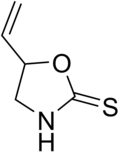Thiocarbamate
Thiocarbamate is a class of organic compounds characterized by the functional group R2NCS2, where R can be an alkyl or aryl group. Thiocarbamates are sulfur analogs of urethanes and are related to carbamates in structure, differing by the presence of a sulfur atom in place of the oxygen atom within the carbamate group. They find applications in various fields, including agriculture, medicine, and industry, due to their diverse biological activities and chemical properties.
Chemistry[edit]
Thiocarbamates are synthesized through the reaction of amines with carbon disulfide in the presence of an alkali. The general chemical formula is R2NCS2, indicating that two organic groups (R) are bonded to the nitrogen atom, which is further connected to a carbonyl sulfur and a thiocarbonyl sulfur. This unique structure imparts thiocarbamates with distinct chemical and physical properties, such as their ability to act as ligands in coordination chemistry, forming complexes with various metals.
Applications[edit]
Agriculture[edit]
In agriculture, thiocarbamates are widely used as herbicides and fungicides. They control a broad spectrum of weeds and fungal diseases in crops by inhibiting the growth of the target organisms. Some common thiocarbamate herbicides include EPTC (S-ethyl dipropylthiocarbamate) and butylate (S-ethyl diisobutylthiocarbamate), which are applied pre-emergence to control grasses and broadleaf weeds.
Medicine[edit]
In the medical field, certain thiocarbamate compounds exhibit pharmacological activities, including antifungal, antibacterial, and anticancer properties. For example, disulfiram (tetraethylthiocarbamate) is used in the treatment of alcohol dependence by inhibiting the enzyme acetaldehyde dehydrogenase, leading to unpleasant effects when alcohol is consumed.
Industry[edit]
Thiocarbamates also find applications in the chemical industry as flotation agents in mineral processing, where they are used to enhance the separation of minerals from ores. Additionally, they serve as intermediates in the synthesis of other chemical compounds, including pharmaceuticals and dyes.
Safety and Environmental Concerns[edit]
The use of thiocarbamate herbicides and fungicides in agriculture has raised concerns regarding their impact on the environment and human health. Some thiocarbamates are classified as potential endocrine disruptors and may contaminate water sources through agricultural runoff. Therefore, their application is regulated in many countries to minimize environmental exposure and protect public health.
Conclusion[edit]
Thiocarbamates are versatile compounds with significant applications in agriculture, medicine, and industry. Their unique chemical properties enable them to perform various functions, from controlling pests and diseases in crops to treating medical conditions in humans. However, the environmental and health safety of these compounds necessitates careful management and regulation to ensure their benefits are realized without adverse effects.

This article is a agriculture stub. You can help WikiMD by expanding it!
-
Thiocarbamate structure
-
Newman-Kwart rearrangement
-
Goitrin structure
Ad. Transform your life with W8MD's Budget GLP-1 injections from $75


W8MD offers a medical weight loss program to lose weight in Philadelphia. Our physician-supervised medical weight loss provides:
- Weight loss injections in NYC (generic and brand names):
- Zepbound / Mounjaro, Wegovy / Ozempic, Saxenda
- Most insurances accepted or discounted self-pay rates. We will obtain insurance prior authorizations if needed.
- Generic GLP1 weight loss injections from $75 for the starting dose.
- Also offer prescription weight loss medications including Phentermine, Qsymia, Diethylpropion, Contrave etc.
NYC weight loss doctor appointmentsNYC weight loss doctor appointments
Start your NYC weight loss journey today at our NYC medical weight loss and Philadelphia medical weight loss clinics.
- Call 718-946-5500 to lose weight in NYC or for medical weight loss in Philadelphia 215-676-2334.
- Tags:NYC medical weight loss, Philadelphia lose weight Zepbound NYC, Budget GLP1 weight loss injections, Wegovy Philadelphia, Wegovy NYC, Philadelphia medical weight loss, Brookly weight loss and Wegovy NYC
|
WikiMD's Wellness Encyclopedia |
| Let Food Be Thy Medicine Medicine Thy Food - Hippocrates |
Medical Disclaimer: WikiMD is not a substitute for professional medical advice. The information on WikiMD is provided as an information resource only, may be incorrect, outdated or misleading, and is not to be used or relied on for any diagnostic or treatment purposes. Please consult your health care provider before making any healthcare decisions or for guidance about a specific medical condition. WikiMD expressly disclaims responsibility, and shall have no liability, for any damages, loss, injury, or liability whatsoever suffered as a result of your reliance on the information contained in this site. By visiting this site you agree to the foregoing terms and conditions, which may from time to time be changed or supplemented by WikiMD. If you do not agree to the foregoing terms and conditions, you should not enter or use this site. See full disclaimer.
Credits:Most images are courtesy of Wikimedia commons, and templates, categories Wikipedia, licensed under CC BY SA or similar.
Translate this page: - East Asian
中文,
日本,
한국어,
South Asian
हिन्दी,
தமிழ்,
తెలుగు,
Urdu,
ಕನ್ನಡ,
Southeast Asian
Indonesian,
Vietnamese,
Thai,
မြန်မာဘာသာ,
বাংলা
European
español,
Deutsch,
français,
Greek,
português do Brasil,
polski,
română,
русский,
Nederlands,
norsk,
svenska,
suomi,
Italian
Middle Eastern & African
عربى,
Turkish,
Persian,
Hebrew,
Afrikaans,
isiZulu,
Kiswahili,
Other
Bulgarian,
Hungarian,
Czech,
Swedish,
മലയാളം,
मराठी,
ਪੰਜਾਬੀ,
ગુજરાતી,
Portuguese,
Ukrainian



